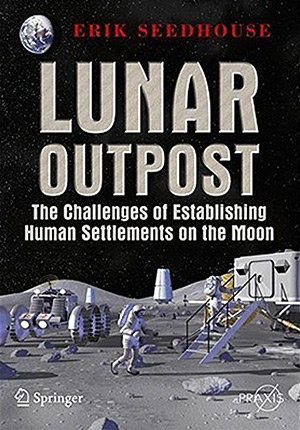Category: Non-Fiction
Reviewed by: David Brandt-Erichsen
Title: Lunar Outpost: The Challenges of Establishing a Human Settlement on the Moon
Author: Erik Seedhouse
NSS Amazon link for this book
Format: Paperback
Pages: 328
Publisher: Springer-Praxis
Date: 2009
Retail Price: $34.95
ISBN: 0387097465
In the opening sentence of the preface, the author clearly states his purpose in writing this book: to present “a narrative of the key mission architecture elements comprising NASA’s plan for returning astronauts to the Moon.” This purpose is admirably accomplished, and anybody who wants a detailed overview of NASA’s [later-cancelled] Constellation program can find it here. What makes the book especially interesting is that it provides more than just a description of the hardware and mission plans to date — it also provides the rationales for how each was arrived at.
The book emphasizes what has already been accomplished and planned in detail — i.e., the hardware currently being built and the contracts currently awarded. Thus, the first half of the book primarily provides details of the Ares I and Ares V launch vehicles and the Orion Crew Exploration Vehicle. There is much less detail on the Altair Lunar Surface Access Module.
Since no baseline lunar outpost design has yet been established, the material about the lunar outpost itself is considerably less detailed. This is entirely in keeping with the book’s purpose. There is fairly extensive discussion of the mission architecture that has already been established (Earth-orbit rendezvous combined with lunar orbit rendezvous) and the reasons for doing so. There is also discussion of the principles of in-situ resource utilization, particularly the use of lunar regolith for radiation shielding and oxygen extraction, but no timelines are given because none are yet established. In addition, there is a chapter on astronaut selection and medical requirements, with particular emphasis on radiation protection — the author has a doctorate in physiology, and seems concerned that NASA’s plans are not completely adequate in this area.
There are only three chapters that are not directly concerned with the book’s main purpose of describing the Constellation program. Chapter 2 provides a very good overview of the lunar aspirations of China, Japan, Russia, and Europe (India, however, was left out). Chapter 10 provides a brief overview of aspirations for lunar tourism on the part of three companies: Space Adventures (which is currently offering a $100 million lunar flyby), the Artemis Project, and Bigelow Aerospace (which hopes to use it’s inflatable habitats on the Moon as well as in Earth orbit).
Chapter 8 discusses two alternative architectures to Constellation: an alternative goal and an alternative launch vehicle system. An alternative goal of skipping the Moon and going directly to Mars (or instead to a near-Earth asteroid) was examined point-by-point and the author concluded that all the needed technology and experience would best be acquired by going to the Moon first. An alternative launch vehicle system known as Direct Shuttle Derivative (DIRECT) was also examined point-by-point. In this case, DIRECT was presented as superior on almost every point, with less cost, shorter development time, and (very significantly) greater lift capability.
The intended audience for the book is unclear to me. It is not a technical book for engineers, and it is not a journalistic account for a general audience. It is somewhere in between, for the seriously interested reader. It’s extensive use of acronyms can be a bit daunting at times (example: “The EDS serves as the CaLV third stage with a role in injecting the LSAM/EDS stack into LEO staging orbit where the LSAM/EDS and CEV rendezvous and dock”). Although each acronym is spelled out on first presentation, I certainly could not remember them all and would have appreciated at least spelling them out on first presentation in each chapter. There is a 10-page list of acronyms, but being on page xxvii it is not as quickly accessable as might be desired. However, I don’t know how the author could have packed such a large quantity of information into a 300-page book without relying a lot on acronyms. And as a non-engineer space activist, I did not have any trouble understanding the book.
Although the subtitle of the book provides a nice homage to the goal of a settlement on the Moon, the book is really about currently planned precursors to settlement — settlement itself is barely mentioned. For readers interested in a book about lunar settlement, I highly recommend (from the same publisher) The Moon: Resources, Future Development, and Settlement, which picks up where this book leaves off and takes the subject all the way to the creation of a global lunar civilization. Whereas The Moon describes what could be done in the future, Lunar Outpost describes what is being done in the present. As such, the two books are perfectly complementary, and both provide an excellent resource for the reader.
© 2009 David Brandt-Erichsen
Please use the NSS Amazon Link for all your book and other purchases. It helps NSS and does not cost you a cent! Bookmark this link for ALL your Amazon shopping!



















